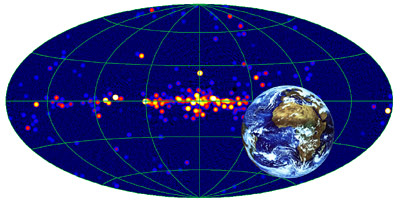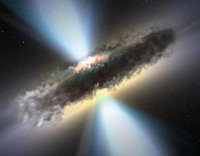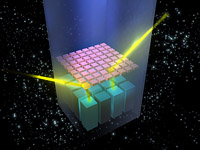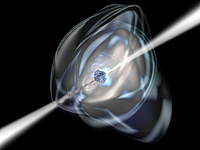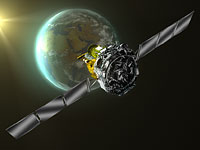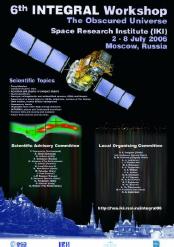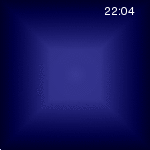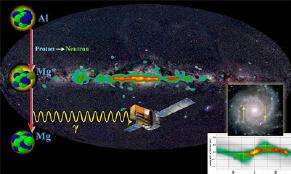INTEGRAL News Archive for 2006 - INTEGRAL
INTEGRAL News archive for 2006
INTEGRAL AO-5 Key Programme approved
19 December 2006 After assessing 22 proposals for Key Programme observations to be executed during the INTEGRAL AO-5 period, the Time Allocation Committee recommended 4 of them, with two merged into one observation program, for a total of 6 Msec. This programme has been approved by the Director of the Scientific Programme (Prof. David Southwood).
| Key Programme Proposals | ||||
| Proposer | Country | Proposal Title | Target area | Time [ks] |
| Belanger | Spain | Deep INTEGRAL Observations of the Central Molecular Zone | Galactic Center |
2000 |
| Ajello | Germany | The ultra-deep INTEGRAL legacy hard X-ray survey | North Ecliptic Pole |
2000 |
| Knoedlseder | France | Nucleosynthesis and anti-matter annihilation in Cygnus X | Cygnus region |
2000 |
| Butt | USA |
Imaging the Hyperactive Cygnus TeV Super-structure inSoft Gamma-rays |
Cygnus region |
To be merged with above |

INTEGRAL AO-5 preparation
01 December 2006 ISOC is preparing the release of the next Announcement of Opportunity (AO-5). Key milestones are shown below.
| Release of AO-5: | 12 March 2007 |
| Due date for Proposals: | 20 April 2007 |
| TAC Meeting: | 29 May - 01 June 2007 |
| Communication of TAC results: | June 2007 |
| AO-5 observing cycle: | 16 August 2007 - 15 August 2008 |

INTEGRAL catches a new erupting black hole
27 November 2006 ESA's gamma-ray observatory, INTEGRAL, has spotted a rare kind of gamma-ray outburst. The vast explosion of energy allowed astronomers to pinpoint a possible black hole in our Galaxy.
The outburst was discovered on 17 September 2006 by staff at the INTEGRAL Science Data Centre (ISDC), Versoix, Switzerland. Inside the ISDC, astronomers constantly monitor the data coming down from INTEGRAL because they know the sky at gamma-ray wavelengths can be a swiftly changing place.
"The galactic centre is one of the most exciting regions for gamma ray astronomy because there are so many potential gamma-ray sources," says Roland Walter, an astronomer at the ISDC, and lead author of these results.
To reflect the importance of this region, INTEGRAL is now running a Key Programme, in which almost four weeks of its observing time is given over to the study of the galactic centre. This is allowing astronomers to understand the gamma-ray characteristics of the galactic centre and its celestial objects, better than ever before.
For more information, see the ESA Space Science News: INTEGRAL catches a new erupting black hole

First statistics from the AO-5 KP
20 November 2006 The deadline (17 November 2006) for submission of INTEGRAL proposals for "Key Programmes" (KP) for the AO-5 cycle of observations has been passed.
An INTEGRAL "Key Programme" is a scientific investigation which requires a very significant fraction of the observing time (available per year) in order to achieve its scientific objectives. The AO-5 cycle of observations will commence on 17 August 2007 with a duration of 12 months.
Below are some high level statistics on the KP proposals that have been received.
The total number of proposals received was 22 including 7 proposals each in the science categories "Nucleosynthesis" and "Extragalactic objects" , and 4 proposals each in science categories "Compact galactic objects" and "Others/miscellany" . About 50% of the submissions propose a "multi-year" programme, i.e. observations to be carried out beyond the AO-5 cycle of observations.
The total observing time requested for the AO-5 cycle is about 52 Msec. Given that up to about 6 Msec (TBC) of observing time would be available for Key Programmes during the AO-5 observing programme (12 months duration starting on 17 August 2007), this corresponds to an oversubscription by a factor of about 8.7 . This is a very high value, showing the high interest of the scientific community in this new programme element of the INTEGRAL mission.
Proposals are currently being peer reviewed and recommendations of the scientific observing programme will be made to ESA before the end of this year. Observations of selected KP's during the AO-5 cycle will commence on 17 August 2007.
Christoph Winkler
INTEGRAL Project Scientist

The AO-5 KP is now open!!!
09 October 2006 Today, the Director of the Scientific Programme (Prof. David Southwood) has released the Announcement of Opportunity for Key Programme (KP) observing proposals for the AO-5 Cycle of observations with INTEGRAL. This announcement solicits proposals for observations to be caried out in the period from August 2007 to August 2008. Proposers from all over the world are welcome to participate. All proposals will be subject to an independent peer review by the INTEGRAL Time Allocation Committee (TAC). The deadline for Proposals submission is 17 November 2006, 15.00 CET (14.00 GMT). More information can be found on the INTEGRAL homepage (AO-5 KP section).

ESA steps towards a great black hole census
07 September 2006 Astronomers using ESA's orbiting gamma-ray observatory, INTEGRAL, have taken an important step towards estimating how many black holes there are in the Universe.
An international team, led by Eugene Churazov and Rashid Sunyaev, Space Research Institute, Moscow, and involving scientists from all groups of the INTEGRAL consortium used the Earth as a giant shield to watch the number of tell-tale gamma rays from the distant Universe dwindle to zero, as our planet blocked their view.
"Point INTEGRAL anywhere in space and it will measure gamma rays", says Pietro Ubertini, INAF, Italy and Principal Investigator on INTEGRAL's gamma-ray imager. Most of those gamma rays do not come from nearby sources but from celestial objects so far away that they cannot yet be distinguished as individual sources. This distant gamma-ray emission creates a perpetual glow that bathes the Universe.
Most astronomers believe that the unseen objects are supermassive black holes, millions or billions of times heavier than the Sun and each sitting at the centre of a galaxy. As the black holes swallow matter, the swirling gases release X-rays and gamma rays. Accurately measuring the glow, known as the X-ray and gamma-ray background, is the first step towards calculating how many black holes are contributing to it and how far away in the Universe they are located.
The new INTEGRAL observations were made during January and February 2006 and provide highly accurate data on the gamma-ray background. The key to success was using the Earth as a shield.
Allowing the Earth to enter INTEGRAL's field of view goes against the standard set of nominal observations for the satellite, because the optical devices needed to determine the spacecraft's attitude would be blinded by the bright Earth. So, this operation required remarkable efforts from the ISOC/MOC teams operating the mission, who had to rely on alternative spacecraft control mechanisms. But the risk was worth it: by measuring the decrease of the gamma-ray flux once the Earth had blocked INTEGRAL's view and by making a model of the Earth's atmospheric emission, the astronomers precisely gauged the gamma-ray background.
Another bonus of the INTEGRAL observations is that the observatory's complementary instruments allowed the strength of both X-rays and gamma rays to be measured simultaneously. In the past, different satellites have had to measure the different energies of X-rays and gamma rays, leaving astronomers with the task of having to piece the results together like the pieces of a jigsaw puzzle.
For more information, see the ESA Space Science News: ESA steps towards a great black hole census

ISOC Newsletter #16
01 September 2006 In this issue of the ISOC Newsletter:
- INTEGRAL AO-4 results
- INTEGRAL AO-5 Key Programme
- INTEGRAL Publication Status
- Science highlights
- Science operations - Highlights
- The ISOC Science Data Archive
- The 6th INTEGRAL Workshop
Read more in the ISOC Newsletter #16.

INTEGRAL AO-4 short and long term planning now available
08 August 2006 ISOC has begun to plan observations in the time frame of the INTEGRAL AO-4, which starts in revolution 469 (Aug 16, 2006) and ends in revolution 590 (Aug 15, 2007). Details can be found at the INTEGRAL Target and Scheduling Information web pages. Note the new feature on these pages to see where INTEGRAL is or will be pointing to on the sky.
ISOC has also released the AO-4 Long-Term Observation Plan which gives an overview of all observations currently foreseen during the AO-4. Note that while this is the best long-term currently available, the schedule will change from time to time, e.g., due to Target of Opportunity observations.

Where are the supermassive black holes hiding?
26 July 2006 European and American scientists, on a quest to find super-massive black holes hiding in nearby galaxies, have found surprisingly few. Either the black holes are better hidden than scientists realised or they are lurking only in the more distant universe.
Scientists are convinced that some super-massive black holes must be hiding behind thick clouds of dust. These dusty shrouds allow only the highest energy X-rays to shine through. Once in space, the X-rays combine into a cosmic background of X-rays that permeates the whole of space.
The search for hidden black holes is part of the first census of the highest-energy part of the X-ray sky. Led by Loredana Bassani, IASF, Italy, a team of astronomers published results in The Astrophysical Journal Letters in January this year. They show the fraction of hidden black holes in the nearby Universe to be around 15 percent, using data from ESA's orbiting gamma-ray observation, the International Gamma Ray Astrophysics Laboratory (INTEGRAL).
Now astronomers from NASA Goddard Space Flight Center in Greenbelt, Maryland, and the INTEGRAL Science Data Centre near Geneva, Switzerland, have found an even smaller fraction using nearly two years of continuous data, also from INTEGRAL. The work shows that there is clearly too few hidden black holes in the nearby Universe to create the observed X-ray background radiation.
For more information, see the ESA Space Science News: Where are the supermassive black holes hiding?

Call for Proposals on "Key Programme observations with INTEGRAL" in October 2006
11 July 2006 This is to notify the scientific community at large about a Call for Proposals on "Key Programme observations with INTEGRAL" which will be released in October 2006.
A Key Programme is a scientific investigation which requires a very significant amount of the available annual observing time in order to achieve its scientific goals compatible with the INTEGRAL prime scientific objectives.
The Key Programme (KP) is a new feature in the INTEGRAL observing programme. It has been successfully introduced as a "pilot project" in the 4th Call for Proposals (AO-4) which was released in March 2006 and which has triggered the scientific community to submit 43 proposals for targets to be associated with that KP for the AO-4 cycle of observations to commence on 16 August 2006 (see the AO-4 INTEGRAL Key Programme Document and AO-4 Key Programme target list for more details).
Consequently, it has been decided to issue a special Call for new Key Programme observations (only). Successful proposals will be conducted during the AO-5 cycle of observations scheduled to start in August 2007.
This call for INTEGRAL KP proposals will solicit proposed investigations to be considered as Key Programmes only.
Successful KP proposals resulting from this Call will be known before the release of the next call for normal observing proposals (AO-5) scheduled for release in Spring 2007 and they will be scheduled for execution during the AO-5 observing cycle which will commence in August 2007. The list of selected KP proposals will be published in the subsequent AO-5 document package such that the scientific community is aware of them and can also submit proposals for individual targets (point sources or extended areas) which are covered by the sky areas exposed to KP proposals (and not blocked by the KP investigation) and which shall be considered as proposals associated with KP's in AO-5.
The key milestones for the Call for KP proposals are as follows:
| 09 October 2006: | Release of the guideline documentation for the Key Programme AO |
| 23 October 2006: | ISOC tools (s/w and associated user manuals) available for KP proposal submission |
| 17 November 2006: | Deadline KP proposal submission |
| December 2006: | Peer review KP proposals and recommendations for selection |
| December 2006: | ESA approval of selected KP proposals |
| March 2007: | Release of Call for Observations (AO-5) including publication of selected KP proposals |
All necessary documentation and further information can be found as usual on the INTEGRAL/ISOC homepage.
Christoph Winkler
INTEGRAL Project Scientist
11 July 2006

INTEGRAL AO-4 General Programme approved
26 June 2006 The INTEGRAL AO-4 General Programme, as recommended by the Time Allocation Committee and approved by the Director of the Scientific Programme (Prof. David Southwood) has been released.

INTEGRAL sees a GRB out of the corner of its eye
16 June 2006 Thanks to a clever piece of design and a sophisticated piece of analysis by European astronomers, INTEGRAL - ESA's orbiting gamma ray observatory - can now make images of the most powerful gamma-ray bursts even if the spacecraft itself is pointing somewhere completely different.
Scientists know that once every day or two, a powerful gamma ray burst (GRB) will take place somewhere in the Universe. Most will last between 0.1 and 100 seconds, so if your telescope is not pointing in exactly the right place at the right time, you will miss taking an image of it - unless that telescope is INTEGRAL. The satellite can now take images round corners, if the gamma-ray blast is strong enough.
When GRB 030406 exploded unexpectedly in early April this year, INTEGRAL was observing another part of the Universe, about 74 times the diameter of the full Moon away. Nevertheless Dr Radoslaw Marcinkowski, Space Research Center, Warsaw, Poland, and colleagues have reconstructed an image of the event using the radiation that passed through the side of INTEGRAL's imaging telescope.
The key is that the Imager on-Board INTEGRAL Satellite (IBIS) uses two detector layers, one on top of the other. Most gamma-ray telescopes contain just a single detector layer. In IBIS, the higher energy gamma rays trigger the first detector layer, losing some energy in the process, but they are not completely absorbed. This is known as Compton scattering. The deflected gamma rays then pass through to the layer below where they can be captured and absorbed because they have given up some energy in their passage through the first layer.
"In this way, we are able to capture and analyse the higher energy gamma rays," says Marcinkowski. IBIS can now see around corners because Marcinkowski realised that gamma rays from the most powerful GRBs would pass through the lead shielding on the side of the telescope, then through the first detector layer before coming to rest in the second layer. The scatter locations in the two detector layers and the energy deposits can then be used to determine the direction of the GRB.
For more information, see the ESA Space Science News: INTEGRAL sees a GRB out of the corner of its eye

New features in the ISOC Science Data Archive (ISDA)
22 May 2006
Querying other archives from the ISDA
In the recently deployed version 2.5 of the ISOC Science Data Archive (ISDA), it is possible to perform queries to external archival facilities. A new pop-up panel appears after clicking on the button "Query other Archives", which is located besides each record of an observation or SCW list. This panel allows users to define the radius of a cone search around the nominal INTEGRAL pointing direction, and the external archive facility (or facilities) to be searched. More then 20 external archives can be queried from the ISDA user interface:
- high-energy mission archives (all the main X-ray and gamma-ray observatories from Einstein to XMM-Newton)
- observatories in other wavelengths (IRAS, ISO, IUE, MAST, Spitzer, etc.)
- source catalogs, both the X-ray domain (RASS) and in other wavelengths (2MASS, MSX) as well as general catalogue services (Simbad, NED, Vizier)
The result of the queries depends on the nature of the external archive being searched. Generally, a list of the observations whose field-of-view overlaps the INTEGRAL observation's one, or of the sources falling in the INTEGRAL field-of-view are returned. Whenever allowed by the external facility, a direct link to data download is provided.
Second IBIS/ISGRI Soft Gamma-ray Survey Catalogue
Also in ISDA version 2.5 it is possible to retrieve data from Second IBIS/ISGRI Soft Gamma-ray Survey Catalogue. The full catalogue, including associated light-curves and spectra can be accessed via the ISDA browser interface. Alternatively a FITS file containing source positions and broad-band fluxes can be downloaded.
Should you have any questions or suggestions about these or any other ISDA facilities, please do not hesitate to contact the INTEGRAL HelpDesk.

New instrument settings and SPI annealing
19 May 2006 1) The background counting rates seen in the INTEGRAL instruments are increasing. In the last few months this has resulted in valuable science data being lost, as the allocated telemetry of 129 packets to IBIS, 103 to SPI, 8 to JEM-X1, 1 to JEM-X2 and 5 to OMC per 8 sec has started to be fully used by SPI and increasingly by IBIS on many occasions. In order to alleviate the situation, ESA, in consultation with the instrument teams, has decided to change the telemetry production of some of the instruments, as well as the allocation of telemetry between the different INTEGRAL instruments.
At short notice one telemetry packet was allocated to SPI, and taken from IBIS, from Revolution 421 (i.e., March 25, 2006). Further setting changes were investigated and defined. These will be effective from Revolution 441, i.e., from May 24, 2006.
With respect to IBIS it was decided to reduce the number of indirect mode packets produced with a minimal impact on science yield. This is accomplished by incrementing the integration time of the Spectral Timing packets of PICsIT by a factor of four from 3.90625 msec to 15.625 msec, while doubling the number of energy channels from 4 to 8. Increasing the PICsIT integration time means a loss in sensitivity for fast pulsars, but doubling the number of energy channels helps in GRB studies. The boundaries of the 8 Spectral Timing channels are set to:
Channel 1: 208-260 keV,
Channel 2: 260-312 keV,
Channel 3: 312-364 keV,
Channel 4: 364-468 keV,
Channel 5: 468-572 keV,
Channel 6: 572-780 keV,
Channel 7: 780-1196 keV,
Channel 8: 1196-2600 keV.
Another change is to switch off the DPE (Data Processing Electronics) of the dormant JEM-X2 unit and to the re-allocate one telemetry packet currently used to transmit housekeeping data of this unit to the SPI science telemetry.
In summary, the new default telemetry allocation will be 128 packets for IBIS, 105 for SPI, 8 for JEM-X1, 0 for JEM-X2 and 5 for OMC.
2) In order to maintain the SPI high spectral resolution, a new SPI annealing period has been agreed. The 8th annealing will start in Revolution 446 (i.e., June 8, 2006) and will have a duration of about 6 revolutions. The long-term plan has been updated accordingly.

4th Announcement of Opportunity (AO-4) preliminary statistics
26 April 2006 The deadline (21 April 2006) for submission of INTEGRAL proposals for AO-4 open time observations is now a few days behind us. All proposals are in the ISOC database. Below are some preliminary statistics on the proposals that have been received.
Total number of proposals
The total number of proposals received was 142. The total observing time requested is approximately 128 Msec (for all types of observation, i.e. fixed time, normal time, and TOO). Here, 10% of the requested total TOO time has been taken into account. Given that up to about 16 Msec of observing time are available for the AO-4 observing programme (12 months duration starting on 16 August 2006, excluding the Key Programme (2 Ms)), this corresponds to an oversubscription by a factor of about eight (8) (see details below). This is a very high value, showing the continued high interest of the scientific community in the INTEGRAL mission.
As a new feature in the AO-4, the pilot "Key Programme" observation of the Galactic Centre region for a total of 2 Msec was included in this Call, and scientists were also invited to submit proposals for the data analysis of scientific targets located in this region. A total number of 43 proposals (included in the total of 142 received proposals), associated with the "Key Programme", was received. These associated proposals do not require additional observatory time.
Proposals per category
In the following table we give the breakdown of number of proposals as a function of the proposal category. The numbers for proposals associated with the Key Programme are given in brackets. Note that the numbers on requested observing times do include TOO proposals, but it has been assumed here, that a typical TOO proposal requests about 10% of its total observing time as entered into PGT from all the candidate sources included in a TOO proposal. Further analysis may modify this assumption but the impact on the overall results should not be large.
| Category | N[1] | T[2] (x 106 s) |
F[3] | % (proposals) |
% (time) |
| Compact objects | 50 (29) |
40.6 (-) |
2.54 | 55.6 | 31.7 |
| Extragalactic objects | 23 (3) |
44.1 (-) |
2.76 (-) |
18.3 | 34.4 |
| Nucleosynthesis | 13 (2) |
34.8 (-) |
2.18 (-) |
10.6 | 27.2 |
| Miscellaneous | 13 (9) |
8.6 (-) |
0.54 (-) |
15.5 | 6.7 |
| Total request obs time Total assoc with KP Total |
99 (43) 142 |
128.1 (-) 128.1 |
8.01 (-) 8.01 |
100 |
100 |
Numbers for proposals associated with the Key Programme, not requesting observing time, are given in brackets
[1] N = number of proposals
[2] T = requested observing time (for TOO x 0.1)
[3] F = oversubscription factor
The Time Allocation Committee, in charge of peer reviewing all proposals, and recommending the scientific observing programme to ESA, will meet 30 May - 02 June at ESTEC, followed by ESA's announcement of the final AO-4 observing programme shortly afterwards. Observations of the AO-4 cycle will commence on 16 August 2006.
Christoph Winkler
INTEGRAL Project Scientist
26 April 2006

Vacancy at ISOC
07 April 2006 There is a vacancy for a Scientist in the INTEGRAL Science Operations Centre (ISOC) located at the European Space Astronomy Centre (ESAC), situated near Madrid, Spain.
Applicants should have a Ph.D degree in physical sciences or equivalent qualification with good knowledge of space astronomy, preferably in high-energy astrophysics. Experience in science operations of space-based observatories is highly desirable. Knowledge and experience of the development and use of scientific software would be a significant advantage.
Applications from external candidates for this post should reach the ESOC Human Resources Division not later than 4 May 2006, and should preferably be made on-line at the ESA Web Site (www.esa.int - Careers). Those unable to apply on-line should submit their CV to the Head of the Human Resources Division, ESOC, Robert-Bosch strasse 5, D-64293 Darmstadt, Germany.

Change in the 5x5 pattern step size
23 March 2006 Following a recommendation from the INTEGRAL science working team, the step size of the standard 5x5 raster pattern has been changed from 2.0 to 2.17 degrees. This change, which will become effective as of revolution 421 will further improve the imaging performance of the IBIS instrument on-board INTEGRAL.
As a side effect, the effective exposure for JEM-X during 5x5 pattern observations is slightly decreased, please see Table 5 in the updated JEM-X Observers manual for details.

INTEGRAL catches stellar 'corpses' by the tail
16 March 2006 Tiny stellar 'corpses' have been caught blasting surprisingly powerful X-rays and gamma rays across our galaxy by ESA's gamma-ray observatory INTEGRAL. This discovery links these objects to the most magnetically active bodies in the Universe and forces scientists to reconsider just how dead such stellar corpses really are.
Known as anomalous X-ray pulsars (AXPs), the stellar corpses were first spotted pulsing low-energy X-rays into space during the 1970s by the Uhuru X-ray satellite. AXPs are extremely rare with only seven known to exist. The X-rays were first thought to be produced by matter falling from a companion star onto the AXP.
An alternative was that each AXP is the spinning core of a dead star, known as a neutron star, sweeping beams of energy through space like a cosmic lighthouse. When these beams cross Earth's line of sight, the AXP blinks on and off.
However, this scenario required the AXP's magnetic field to be a thousand million times stronger than the strongest steady magnetic field achievable in a laboratory on Earth. Nevertheless, the INTEGRAL observations show that the magnetic solution is correct.
The newly detected emission, known to astronomers as a hard tail, of high-energy (hard) X-rays and gamma rays also comes in the form of regular pulses every 6 to 12 seconds depending upon which AXP is observed.
For more information, see the ESA Space Science News: INTEGRAL catches stellar 'corpses' by the tail and the Astrophysical Journal (ApJ) paper entitled "Discovery of luminous pulsed hard X-ray emission from anomalous X-ray pulsars 1RXS J1708-4009, 4U 0142+61 and 1E 2259+586 by INTEGRAL and RXTE" by Kuiper et al.

The AO-4 is now open !!!
13 March 2006 Today, the Director of the Scientific Programme (Prof. David Southwood) has released the 4th Announcement of Opportunity (AO-4) for observing proposals with INTEGRAL. This announcement solicits proposals for observations to be caried out in the period from August 2006 to August 2007. Proposers from all over the world are welcome to participate. All proposals will be subject to an independent peer review by the INTEGRAL Time Allocation Committee (TAC). Potential proposers are expected to prepare and submit proposals in electronic form by using the INTEGRAL Proposal Generation Tool (PGT) software. The deadline for Proposals submission is 21 April 2006, 15.00 CET (14.00 GMT). More information can be found on the INTEGRAL homepage (AO-4 section) and the AO-4 Documentation page.

INTEGRAL looks at Earth to seek source of cosmic radiation
13 February 2006 Cosmic space is filled with continuous, diffuse high-energy radiation. To find out how this energy is produced, the scientists behind ESA's INTEGRAL gamma-ray observatory have tried an unusual method: observing Earth from space.
During a four-phase observation campaign started on 24 January this year, continued until 9 February, INTEGRAL has been looking at Earth. Needing complex control operations from the ground, the satellite has been kept in a fixed orientation in space, while waiting for Earth to drift through its field of view.
Unusually, the main objective of these observations is not Earth itself, but what can be seen in the background when Earth moves in front of the satellite. This is the origin of the diffuse high-energy radiation known as the cosmic X-ray background. Until now with INTEGRAL, this was never studied simultaneously with such a broad band of energy coverage since the 1970s, and certainly not with such advanced instruments.
Astronomers believe that the cosmic X-ray background is produced by numerous supermassive and accreting black holes, distributed throughout deep space. These powerful monsters attract matter, which is then hugely accelerated and so emit high energy in the form of gamma- and X-rays.
For more information, see the ESA Space Science News: INTEGRAL looks at Earth to seek source of cosmic radiation

The 6th INTEGRAL Workshop "The Obscured Universe" (2nd circular)
30 January 2006 The 6th INTEGRAL (International Gamma-Ray Astrophysics Laboratory) Workshop ``The Obscured Universe'' changed its location announced in the first circular and finally will be held at the Space Research Institute (IKI), Moscow, Russia on July 2-8, 2006 (the working days July 3-7).
The main goal of this workshop is to consider (via invited and contributed talks and posters) the scientific problems in the field of high energy astrophysics which are possible to solve using INTEGRAL as well as to present and discuss the scientific results obtained by this observatory and its coordinated observations with on-ground telescopes and other spacecrafts.
Presentations shall cover the following scientific topics:
- X-ray binaries (IGR sources, black-holes and neutron stars)
- Isolated neutron stars (gamma-ray pulsars, soft gamma-ray repeaters)
- Accretion and physics of compact objects, strange stars, microquasars
- Nucleosynthesis (SNe and SNRs, gamma-ray lines, diffuse emission)
- Surveys, extragalactic and unidentified sources, AGNs and blazars
- Super/massive black holes in AGNs, ellipticals, nucleus of the Galaxy
- INTEGRAL and dark matter, cosmic background
- Gamma-ray bursts
- Highlights from other high energy missions
- INTEGRAL status and instrument overviews (invited talks only)
- Science data processing and analysis (posters only)
- Future instruments and missions (posters only)
Deadline for abstract submission/pre-registration is March 1, 2006.
The workshop is jointly co-sponsored by IKI (Space Research Institute), ESA (European Space Agency), RAS (Russian Academy of Sciences) and RFBR (Russian Foundation for Basic Reseach).
Detailed information on abstract submission, workshop registration, hotel booking, visa receiving, travel support, social events, Moscow attractions as well as useful links to Moscow tourist guides and weather servers are available at the www-pages (http://hea.iki.rssi.ru/integral06/) of the Local Organizing Committee (LOC).

INTEGRAL observed the Earth!
25 January 2006 INTEGRAL observed the Earth in the night of 24-25 January 2006 (rev. 401). Further observations are planned early February during revolutions 404, 405 and 406. These data are immediately public (after a delay of a few working hours to produce the tar file) and are available for download from the ISDC ftp site.
The aim of the observation is to determine (in particular in the range between 20 keV and 200 keV) the intensity and the spectrum of the diffuse X-ray background (XRB) being occulted by the Earth. The observation will also allow astronomers to study the emission from the Earth atmosphere expected to come both from reflection of the XRB and interaction of cosmic rays in the atmosphere. The observation was performed by letting the Earth move through the field of view as shown in the simulation below.
Simulation of the first INTEGRAL Earth observation on 24-25 January 2006. The animation shows the passage of the Earth through the IBIS field of view assuming nominal spacecraft attitude and Earth position.. It takes into account the decreasing exposure outside of the fully coded field-of-view (the central square), the decreasing efficiency with radius (nomex vignetting). The Earth is occulting the diffuse X-ray background (XRB), but its atmosphere is also emitting X-rays both through reflection of the XRB and through interaction of cosmic rays. Please note that the intensity of this simulated emission does not correspond to a physical value, but was chosen to be bright enough to be clearly seen on the image. The UTC time corresponding to each frame is given in the upper right of the image. Credit: ISDC/M. Türler et al.

INTEGRAL identifies supernova rate for Milky Way
05 January 2006 Using ESA's INTEGRAL observatory, an international team of researchers has been able to confirm the production of radioactive aluminium (Al 26) in massive stars and supernovae throughout our galaxy and determine the rate of supernovae - one of its key parameters.
The team, led by Roland Diehl of the Max Planck Institute for Extraterrestrial Physics in Garching, Germany, determined that gamma rays from the decay of Al 26 originate from the central regions of our galaxy, implying that production of new atomic nuclei is an ongoing process and occurs in star-forming regions galaxy-wide.
Our environment is composed of chemical elements formed long ago by nuclear fusion reactions in stellar interiors and supernovae. This process of nucleosynthesis leads to the emission of gamma rays, which easily reach us from all regions of our galaxy. ESA's INTEGRAL observatory has been measuring such gamma rays since October 2002.
For more information, see the ESA Space Science News: INTEGRAL identifies supernova rate for Milky Way

See also:
- The INTEGRAL News Archive:
[1995 - 2000] [2001] [2002] [2003] [2004] [2005] [2006] [2007] [2008] [2009] [2010] [2011] [2012] [2013] [2014] [2015] [2016] [2017] [2018] [2019] [2020] [2021] [2022] [2023] [2024] - INTEGRAL Commissioning & Performance Verification (PV) phase report
- INTEGRAL launch status reports
- ESA SciTech Website: News from the launch campaign
- ESA SciTech Website: News Archive about INTEGRAL
- The INTEGRAL Science Data Centre (ISDC) Newsletters

